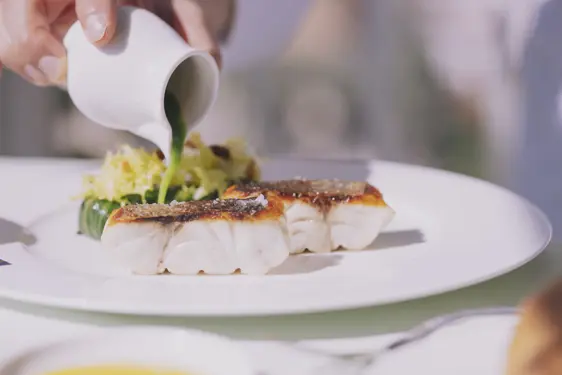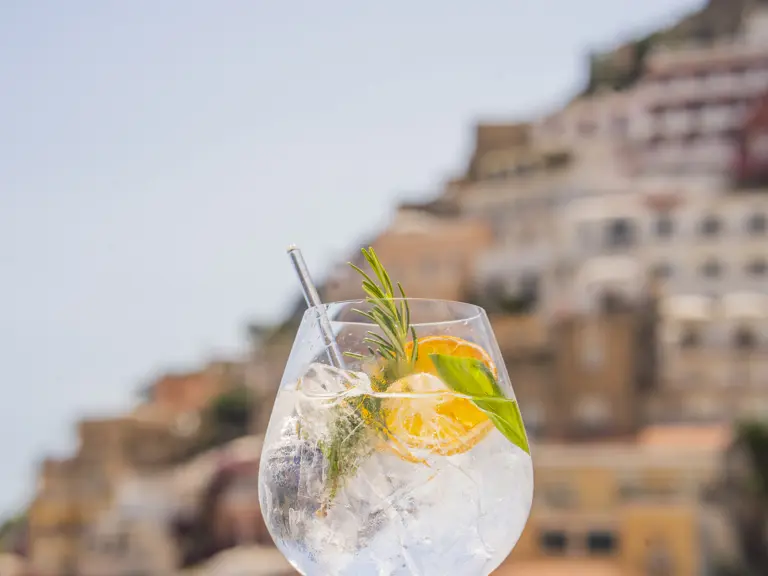ROAST SEA BASS WITH ESCAROLE
07.04.2022 RECIPES
Called branzino in Italian, the Mediterranean sea bass is a versatile, flaky white fish that goes equally well with tomatoes and potatoes, zucchini, peppers and a range of herbs and spices. Gennaro pairs it here with escarole, a kind of lettuce that is generally cooked rather than eaten raw. For the record, escarole or scarola actually belongs to the chicory family, along with radicchio and other bitter greens, but it looks just like an elongated pale green lettuce. In Italy, it’s perhaps most often served as a contorno or side dish, cooked with black olives, pine nuts and sultanas (which set off its slightly bitter taste), but in this light, summery recipe Gennaro prepares it in the manner of Greek stuffed vine leaves, or dolmades.
One thing Gennaro loves about this recipe is that nothing is wasted. Every single scarola leaf is used – in three different ways. “That’s just the way we do things down here”, lo chef tells us.

View
ROAST SEA BASS WITH ESCAROLE
Serves 4
- A large sea bass filleted into eight ‘steaks’ of around 85g (3oz) each
- 5 heads of escarole
- 1 small to medium cauliflower
- 150g (5.25oz) stoneless small black olives (preferable the Italian ‘Taggiasche’ variety)
- 6 anchovy fillets (preserved in oil or salt)
- 50g (1.75oz) salted capers, the best you can find
- 150g good vegetable broth
- Olive oil, white wine vinegar and salt as required
A reputable fishmonger should be able to do the filleting for you (if they’re in any doubt, show them the photo!). Make sure the fish is descaled, but leave the skin on one side of each fillet.
Begin by soaking the capers in abundant water to reduce their salt content. (Don’t be tempted to cut corners by using capers soaked in brine – they taste nothing like real capers should).
Next, take two of your five escaroles and remove four of the largest and healthiest looking outer leaves (though you may need eight if they’re on the small side). Put these aside: these are the ‘envelopes’ of the escarole parcels.
Now turn your attention to the escarole sauce that you will pour on the fish, and the salad that will garnish the escarole parcels.
For the sauce, continue removing leaves from the same two escaroles until you have exposed their tender hearts. Throw these outer leaves into vigorously boiling water and cook until soft. Place in a mouli with a mix of their own cooking water and vegetable stock, and blitz to create a vitamin-rich green sauce that should be of pouring consistency, but not too thin.
For the salad, take the two escarole hearts and strip the tender leaves off one by one. Toss these in a salad bowl with a little olive oil and salt, 50g (1.75g) olives, cut in half, and two of the anchovy fillets, roughly chopped. Next, boil the cauliflower whole in abundant water to which you will have added a little white wine vinegar (Gennaro calculates 100g for every 3 litres of water) until it is tender but not disintegrating. Separate into small florets (no more than an inch across) and add to the salad. Set aside.
Now throw your four (or eight) escarole ‘parcel’ leaves into boiling water for a few minutes (you can use the same water you cooked the other outer leaves in), then cool immediately in iced water.
Pour a generous spiral of olive oil into a deep-sided frying pan, and when it’s good and hot, throw in three of the escaroles, quartered. Toss for a while, then put in the remaining four anchovy fillets and the final 100g (3.5oz) of the olives. Stir until the anchovies have dissolved into the oil, then add a little water and continue to cook until the escarole leaves are soft and wilted. Covering the pan briefly will speed things up, but don’t forget to keep stirring regularly. Leave to cool, then chop the whole mixture up finely.
Now recover the ‘parcel’ leaves, lay them out as flat as possible, and place around 70g (2.5oz) of the chopped escarole, anchovy and olive mix in the centre of each whole leaf or overlapping pair of leaves to form little packets. Gennaro’s are rectangular, like neat little postal packets, but yours don’t need to be.
Finally, it’s branzino time. Set your oven to 180°C (350°F) then take a good heavy-bottomed frying pan, copper for preference, coat thinly with olive oil, put on a lively heat and when the oil is hot but not smoking, place the eight sea bass fillets in, skin side down. Fry for around four minutes until the skin turns golden, then transfer to a roasting pan and place in the oven for just three minutes.
Place two fillets on each plate, sprinkle some sea salt flakes on top, add the escarole parcels to the side of the plate, top these with the escarole and cauliflower salad and pour a generous ring of green sauce around the fish.
Photos © Roberto Salomone
Le Sirenuse Newsletter
Stay up to date
Sign up to our newsletter for regular updates on Amalfi Coast stories, events, recipes and glorious sunsets



